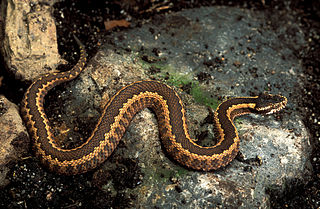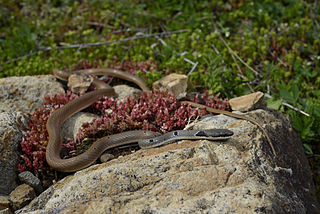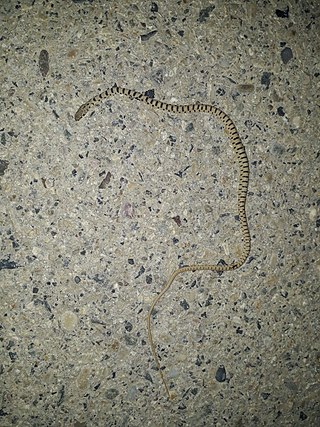
Hardwicke's rat snake, also known commonly as the glossy-bellied racer, Gray's rat snake, and the spotted bellied snake, is a species of snake in the family Colubridae. The species is native to Asia. There are three recognized subspecies.

Eumeces schneiderii, commonly known as Schneider's skink, is a species of lizard in the family Scincidae. The species is endemic to Central Asia, Western Asia, and North Africa. There are five recognized subspecies.

Dasypeltis scabra, known as the common egg eater, egg-eating snake or rhombic egg eater, is a species of snake in the family Colubridae. It is endemic to Africa.

Vipera dinniki is a viper species native to the Caucasus Mountains region, part of Russia, Georgia, and Azerbaijan. Like all other vipers, it is venomous. No subspecies are currently recognized.

Pituophis melanoleucus, commonly known as the eastern pine snake, is a species of nonvenomous snake in the family Colubridae. The species is endemic to the southeastern United States. Three subspecies are currently recognized as being valid.

The red whip snake or collared dwarf racer is a species of snake in the family Colubridae. Native to the Middle East, its natural habitats are Mediterranean-type shrubby vegetation, rocky areas, arable land, pastureland, plantations, and rural gardens.

The European cat snake, also known as the Mediterranean cat snake, is a non venomous colubrid snake endemic to the Mediterranean and Caucasus regions.

Eryx miliaris, known as the dwarf sand boa, desert sand boa, or Tartar sand boa, is a species of snake in the Boidae family. The species is endemic to Asia.

The black-headed ground snake, also known as the Palestine kukri snake is a species of small and elegant harmless snake, which is endemic to the Eastern Mediterranean and the Near East. It belongs to the Colubridae family. Two subspecies, Rhynchocalamus melanocephalus melanocephalus and Rhynchocalamus melanocephalus satunini, are currently recognized.

Dolichophis jugularis, also known commonly as the black whipsnake and the large whip snake, is a species of snake in the family Colubridae. The species is native to West Asia. There are three subspecies.

Platyceps is a genus of snakes of the family Colubridae endemic to Eurasia.

Platyceps karelini, the spotted desert racer, is a species of snake in the family Colubridae. The species is endemic to Asia.
The short racer, is a species of snake in the family Colubridae. The species is endemic to northeastern Africa.
Vipera eriwanensis, commonly known as the Alburzi viper or the Armenian steppe viper, is a species of venomous snake in the family Viperidae. The species is native to western Asia. There are two recognized subspecies.
Tropidosaura montana, also known commonly as the common mountain lizard and the green-striped mountain lizard, is a species of lizard in the family Lacertidae. The species is endemic to South Africa. There are three recognized subspecies.

Phrynocephalus guttatus, also known commonly as the spotted toadhead agama, the Saissan toad-headed agama, the Central Asian toadhead agama, and Salensky's toadhead agama, is a species of lizard in the family Agamidae. The species is native to southeastern Europe and western Asia. There are five recognized subspecies.

Elapsoidea sundevallii, also known commonly as Sundevall's garter snake or the African garter snake, is a species of venomous snake in the family Elapidae. The species is native to Southern Africa. There are five recognised subspecies.
















